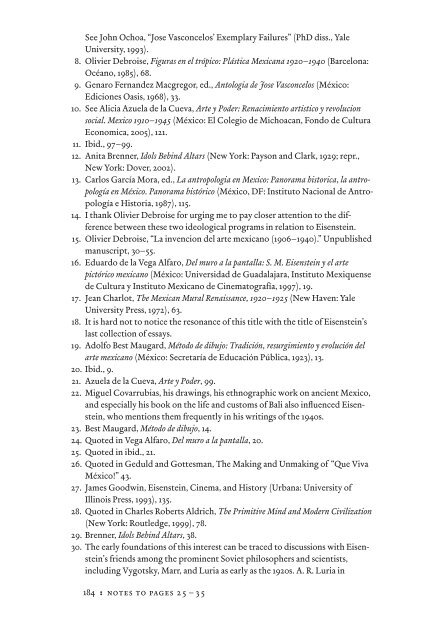In Excess: Sergei Eisentein's Mexico - Cineclub
In Excess: Sergei Eisentein's Mexico - Cineclub
In Excess: Sergei Eisentein's Mexico - Cineclub
You also want an ePaper? Increase the reach of your titles
YUMPU automatically turns print PDFs into web optimized ePapers that Google loves.
See John Ochoa, “Jose Vasconcelos’ Exemplary Failures” (PhD diss., Yale<br />
University, 1993).<br />
8. Olivier Debroise, Figuras en el trópico: Plástica Mexicana 1920–1940 (Barcelona:<br />
Océano, 1985), 68.<br />
9. Genaro Fernandez Macgregor, ed., Antologia de Jose Vasconcelos (México:<br />
Ediciones Oasis, 1968), 33.<br />
10. See Alicia Azuela de la Cueva, Arte y Poder: Renacimiento artistico y revolucion<br />
social. <strong>Mexico</strong> 1910–1945 (México: El Colegio de Michoacan, Fondo de Cultura<br />
Economica, 2005), 121.<br />
11. Ibid., 97–99.<br />
12. Anita Brenner, Idols Behind Altars (New York: Payson and Clark, 1929; repr.,<br />
New York: Dover, 2002).<br />
13. Carlos García Mora, ed., La antropologia en <strong>Mexico</strong>: Panorama historica, la antropología<br />
en México. Panorama histórico (México, DF: <strong>In</strong>stituto Nacional de Antropología<br />
e Historia, 1987), 115.<br />
14. I thank Olivier Debroise for urging me to pay closer attention to the difference<br />
between these two ideological programs in relation to Eisenstein.<br />
15. Olivier Debroise, “La invencion del arte mexicano (1906–1940).” Unpublished<br />
manuscript, 30–55.<br />
16. Eduardo de la Vega Alfaro, Del muro a la pantalla: S. M. Eisenstein y el arte<br />
pictórico mexicano (México: Universidad de Guadalajara, <strong>In</strong>stituto Mexiquense<br />
de Cultura y <strong>In</strong>stituto Mexicano de Cinematografía, 1997), 19.<br />
17. Jean Charlot, The Mexican Mural Renaissance, 1920–1925 (New Haven: Yale<br />
University Press, 1972), 63.<br />
18. It is hard not to notice the resonance of this title with the title of Eisenstein’s<br />
last collection of essays.<br />
19. Adolfo Best Maugard, Método de dibujo: Tradición, resurgimiento y evolución del<br />
arte mexicano (México: Secretaría de Educación Pública, 1923), 13.<br />
20. Ibid., 9.<br />
21. Azuela de la Cueva, Arte y Poder, 99.<br />
22. Miguel Covarrubias, his drawings, his ethnographic work on ancient <strong>Mexico</strong>,<br />
and especially his book on the life and customs of Bali also infl uenced Eisenstein,<br />
who mentions them frequently in his writings of the 1940s.<br />
23. Best Maugard, Método de dibujo, 14.<br />
24. Quoted in Vega Alfaro, Del muro a la pantalla, 20.<br />
25. Quoted in ibid., 21.<br />
26. Quoted in Geduld and Gottesman, The Making and Unmaking of “Que Viva<br />
México!” 43.<br />
27. James Goodwin, Eisenstein, Cinema, and History (Urbana: University of<br />
Illinois Press, 1993), 135.<br />
28. Quoted in Charles Roberts Aldrich, The Primitive Mind and Modern Civilization<br />
(New York: Routledge, 1999), 78.<br />
29. Brenner, Idols Behind Altars, 38.<br />
30. The early foundations of this interest can be traced to discussions with Eisenstein’s<br />
friends among the prominent Soviet philosophers and scientists,<br />
in cluding Vygotsky, Marr, and Luria as early as the 1920s. A. R. Luria in<br />
184 : notes to pages 25 – 35


